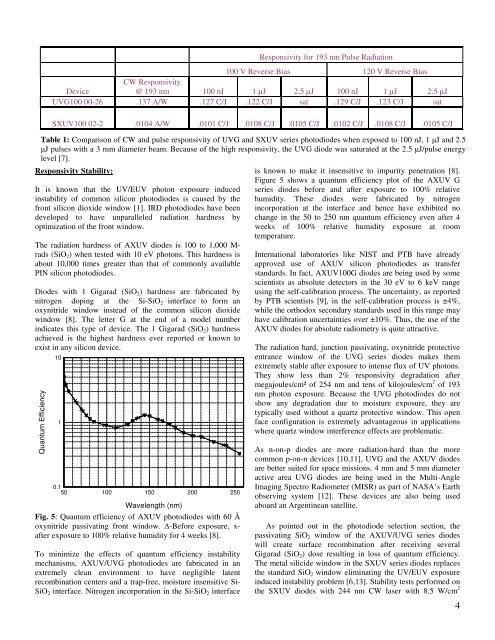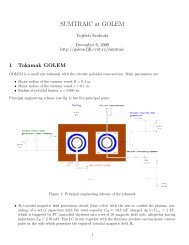IRD Catalogue 2007 - Golem
IRD Catalogue 2007 - Golem
IRD Catalogue 2007 - Golem
You also want an ePaper? Increase the reach of your titles
YUMPU automatically turns print PDFs into web optimized ePapers that Google loves.
Responsivity Stability:<br />
It is known that the UV/EUV photon exposure induced<br />
instability of common silicon photodiodes is caused by the<br />
front silicon dioxide window [1]. <strong>IRD</strong> photodiodes have been<br />
developed to have unparalleled radiation hardness by<br />
optimization of the front window.<br />
The radiation hardness of AXUV diodes is 100 to 1,000 M-<br />
rads (SiO 2 ) when tested with 10 eV photons. This hardness is<br />
about 10,000 times greater than that of commonly available<br />
PIN silicon photodiodes.<br />
Diodes with 1 Gigarad (SiO 2 ) hardness are fabricated by<br />
nitrogen doping at the Si-SiO 2 interface to form an<br />
oxynitride window instead of the common silicon dioxide<br />
window [8]. The letter G at the end of a model number<br />
indicates this type of device. The 1 Gigarad (SiO 2 ) hardness<br />
achieved is the highest hardness ever reported or known to<br />
exist in any silicon device.<br />
Quantum Efficiency<br />
10<br />
1<br />
0.1<br />
50 100 150 200 250<br />
Wavelength (nm)<br />
Fig. 5: Quantum efficiency of AXUV photodiodes with 60 Å<br />
oxynitride passivating front window. ∆-Before exposure, x-<br />
after exposure to 100% relative humidity for 4 weeks [8].<br />
To minimize the effects of quantum efficiency instability<br />
mechanisms, AXUV/UVG photodiodes are fabricated in an<br />
extremely clean environment to have negligible latent<br />
recombination centers and a trap-free, moisture insensitive Si-<br />
SiO 2 interface. Nitrogen incorporation in the Si-SiO 2 interface<br />
Responsivity for 193 nm Pulse Radiation<br />
100 V Reverse Bias 120 V Reverse Bias<br />
Device<br />
CW Responsivity<br />
@ 193 nm 100 nJ 1 µJ 2.5 µJ 100 nJ 1 µJ 2.5 µJ<br />
UVG100 00-26 .137 A/W .127 C/J .122 C/J sat .129 C/J .123 C/J sat<br />
SXUV100 02-2 .0104 A/W .0101 C/J .0108 C/J .0105 C/J .0102 C/J .0108 C/J .0105 C/J<br />
Table 1: Comparison of CW and pulse responsivity of UVG and SXUV series photodiodes when exposed to 100 nJ, 1 µJ and 2.5<br />
µJ pulses with a 3 mm diameter beam. Because of the high responsivity, the UVG diode was saturated at the 2.5 µJ/pulse energy<br />
level [7].<br />
is known to make it insensitive to impurity penetration [8].<br />
Figure 5 shows a quantum efficiency plot of the AXUV G<br />
series diodes before and after exposure to 100% relative<br />
humidity. These diodes were fabricated by nitrogen<br />
incorporation at the interface and hence have exhibited no<br />
change in the 50 to 250 nm quantum efficiency even after 4<br />
weeks of 100% relative humidity exposure at room<br />
temperature.<br />
International laboratories like NIST and PTB have already<br />
approved use of AXUV silicon photodiodes as transfer<br />
standards. In fact, AXUV100G diodes are being used by some<br />
scientists as absolute detectors in the 30 eV to 6 keV range<br />
using the self-calibration process. The uncertainty, as reported<br />
by PTB scientists [9], in the self-calibration process is ±4%,<br />
while the orthodox secondary standards used in this range may<br />
have calibration uncertainties over ±10%. Thus, the use of the<br />
AXUV diodes for absolute radiometry is quite attractive.<br />
The radiation hard, junction passivating, oxynitride protective<br />
entrance window of the UVG series diodes makes them<br />
extremely stable after exposure to intense flux of UV photons.<br />
They show less than 2% responsivity degradation after<br />
megajoules/cm² of 254 nm and tens of kilojoules/cm 2 of 193<br />
nm photon exposure. Because the UVG photodiodes do not<br />
show any degradation due to moisture exposure, they are<br />
typically used without a quartz protective window. This open<br />
face configuration is extremely advantageous in applications<br />
where quartz window interference effects are problematic.<br />
As n-on-p diodes are more radiation-hard than the more<br />
common p-on-n devices [10,11], UVG and the AXUV diodes<br />
are better suited for space missions. 4 mm and 5 mm diameter<br />
active area UVG diodes are being used in the Multi-Angle<br />
Imaging Spectro Radiometer (MISR) as part of NASA’s Earth<br />
observing system [12]. These devices are also being used<br />
aboard an Argentinean satellite.<br />
As pointed out in the photodiode selection section, the<br />
passivating SiO 2 window of the AXUV/UVG series diodes<br />
will create surface recombination after receiving several<br />
Gigarad (SiO 2 ) dose resulting in loss of quantum efficiency.<br />
The metal silicide window in the SXUV series diodes replaces<br />
the standard SiO 2 window eliminating the UV/EUV exposure<br />
induced instability problem [6,13]. Stability tests performed on<br />
the SXUV diodes with 244 nm CW laser with 8.5 W/cm 2<br />
4



